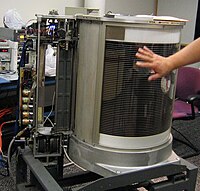
Photo from wikipedia
Abstract Titanium, a difficult-to-cut material, consumes higher time and cost in removing material by machining to produce parts. Machining of Ti alloys has got serious attention owing to its reactive… Click to show full abstract
Abstract Titanium, a difficult-to-cut material, consumes higher time and cost in removing material by machining to produce parts. Machining of Ti alloys has got serious attention owing to its reactive nature with tool materials at elevated temperature that aggravates tool wear. Reportedly, effective and efficient cooling and lubrication at the tool–work interface can ameliorate the machinability of Ti-alloys. In this perspective, this article interrogates the underlying mechanism of critical responses such as surface roughness, temperature, tool life and machining cost under dry, minimum quantity lubrication (MQL) and cryogenic liquid nitrogen (LN2) modes. The effect of cutting speeds and feed rates on such responses have been considered as a function of cooling strategy to standardize the cooling technique as the best alternative for machining. Cryogenic cooling seems to be preponderant regarding machining cost, temperature, surface roughness and tool life in hard turning of a–b titanium alloy. The feasibility of cryogenic cooling was investigated using the iso-response technique in comparison with dry and MQL-assisted hard turning. Experimental results revealed longer tool life and lower machining cost under cryogenic condition followed by MQL and dry machining. Moreover, cryogenic LN2 has been identified as an appropriate alternative to reduce the temperature and surface roughness. On contrary, dry turning evoked a high-temperature and rapid tool wear. In a nutshell, cryogenic assisted hard turning has acceded as a sustainable strategy from an environmental and economic perspective.
Journal Title: Machining Science and Technology
Year Published: 2019
Link to full text (if available)
Share on Social Media: Sign Up to like & get
recommendations!